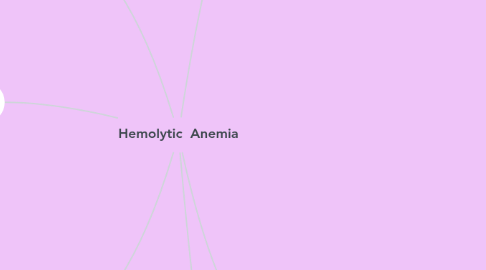
1. Risk Factors
1.1. Genetics
1.2. Infections
1.3. Cardiac valve replacement
1.4. Injury
2. Diagnostic Tests
2.1. Bone Marrow Studies
2.1.1. Increased numbers of erythrocyte stem cells
2.2. Blood Tests
2.2.1. Hemoglobin & Hematocrit
2.2.2. Reticulocyte Count
2.2.3. Billirubin
2.2.4. Mean corpuscular volume
2.2.5. Plasma Iron
3. Common Findings
3.1. Jaundice
3.1.1. Scleral icterus
3.2. Splenomegaly
3.3. Gallstones
3.4. In children skeletal abnormalities due to expansion of erythroid bone marrow.
3.5. Thromboembolism
3.6. Fatigue
3.7. Abdominal pain
3.8. Can be asymptomatic
4. Pathophysiologic etiology
4.1. Destruction of erythrocytes before their normal lifespan, red blood cells from marrow fails to compensate for blood loss, can be chronic or episodic.
4.1.1. Inherited
4.1.1.1. Increased fragility of the cell membrane causes deformity to the cells.
4.1.1.2. complement activation on the erythrocyte surface causes intravascular lysis
4.1.2. Acquired
4.1.2.1. Paroxysmal nocturnal hemglobinuria, secondary disease caused by aplastic anemia
4.1.2.2. Autoimmune hemolytic anemias
4.1.2.2.1. Warm autoimmune hemolytic anemia
4.1.2.2.2. Cold Agglutinin autoimmune hemolytic anemia
4.1.2.2.3. Caused by an allergic reactions against foreign antibodies
4.1.2.2.4. Cold hemolysin autoimmune hemolytic anemia
4.1.2.3. Drug-induced hemolytic anemia
4.1.2.3.1. chemical injury to erythrocytes
4.1.2.4. Traumatic hemolysis
4.1.2.4.1. physical destruction of erythrocytes
4.1.2.5. Infectious hemolysis
4.1.2.5.1. many different mechanisms however destruction of red blood cells by infectious agents interrupts the heme iron stores thereby reducing hemoglobin synthesis
4.1.2.6. Physical hemolysis
4.1.2.6.1. burns/radiation
4.1.2.7. Hypophosphatemic hemolysis
4.1.2.7.1. diminished substance required required for cell function.
4.1.2.8. Paroxysmal nocturnal hemglobinuria, secondary disease caused by aplastic anemia
5. Causative Factors
5.1. Aquired
5.1.1. Immune system
5.1.1.1. Autoimmune hemolytic anemia
5.1.1.2. Isohemagglutinis, mismatched blood transfusions
5.1.2. Traumatic Hemolysis
5.1.2.1. Disseminated intravascular coagulation
5.1.2.2. Prosthetic heart valves
5.1.2.3. Hemodialysis
5.1.2.4. Structural abnormalities of the heart
5.1.2.5. Hemolytic uremic syndrome
5.1.3. Infectious Hemolysis
5.1.3.1. Bacterial, viral, protozoal and helminthic infections
5.1.4. Physical
5.1.4.1. Burns and Radiation
5.1.5. Drug or Toxic
5.1.5.1. Exposure to toxic chemical agents, uremia, or venom exposure
5.1.6. Hypophosphatemic
5.1.6.1. phosphate deficiency
5.2. Inherited
5.2.1. Defects in globin synthesis or structure
5.2.2. Defects in the erythrocytes, defects in the red cell membrane, defects in the enzymatic pathways and defects in the hemoglobin synthesis.
6. Treatment
6.1. Acquired hemolytic
6.1.1. Removing the cause or treating the underlying disorder.
6.1.2. Corticosteriods are used for initial treatment and is 75% effective, most patients relapse after one year.
6.1.2.1. Secondline of treatment is splenectomy and Rituximab
6.1.2.1.1. Most patients are in lifelong remission after splenectomy.
6.1.3. Corticosteriods are used for initial treatment and is 75% effective
6.2. Inherited
6.2.1. Eculizumab, this medication prevents the formation of the membrane attack complex and complement-mediated cell lysis.

